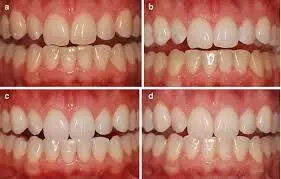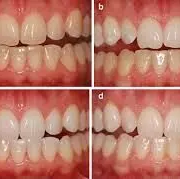Antioxidants Preserve Bleached Enamel Color but Acidic Gels May Pose Enamel Risk: Study

Researchers have found in a new study that antioxidant agents maintained color stability after tooth bleaching and showed high antioxidant activity. However, QUI and QC gels had acidic pH, which may risk enamel damage. Therefore clinically, these antioxidants can aid bond strength recovery without compromising esthetic outcomes, but acidic formulations should be used cautiously.
This study evaluated the color stability of enamel submitted to 10% hydrogen peroxide (HP) followed by antioxidants agents, and the pH and antioxidant activity (AA%) of these agents. Bovine enamel-dentin blocks were randomly distributed into groups (n=10/group): GNC (negative control: no treatment); GPC (positive control: bleaching only); TOC_10% (HP+10% α-tocopherol); GT_10% (HP+10% green tea extract); GS_5% (HP+5% grape seed extract); SA_10% (HP+10% sodium ascorbate); QUI_10% (HP+10% quinoa extract); and QC_1% (HP+1% quercetin). Color (ΔE00) and whiteness index (ΔWID) changes were analyzed using a digital spectrophotometer. The pH and AA% were determined using a pH meter and the DPPH method, respectively. Data were analyzed by ANOVA/Tukey’s and Dunnett’s tests (α=0.05). Results At 14 days post-bleaching, GNC promoted the lowest ΔWID and ΔE00 (p<0.05), and no differences were found between GPC and the remaining groups submitted to the antioxidant agents (p>0.05). QC_1% and QUI_10% exhibited acidic pH levels (3.64 and 4.75, respectively), whereas TOC_10% and GS_5% exhibited alkaline pH (7.07 and 7.64, respectively). No differences in AA% were found between the agents (p>0.05), ranging from 92.6 to 97.6%. The antioxidant agents did not interfere in bleached enamel color stability, showing satisfactory antioxidant activity. However, QUI and QC gels displayed acidic pH. Clinical significance: The antioxidants evaluated showed high AA% and no impact on post-bleaching color stability, suggesting that their capacity to recover bond strength demonstrated elsewhere would not compromise the esthetic efficacy of tooth bleaching. However, those with acidic pH should be used with caution due to potential enamel damage.
Reference:
Alves RO, Nunes GP, Martins TP, Alves de Toledo PT, Ragghianti MHF, Delbem ACB. Effect of Quercetin-Doped Hydrogen Peroxide Gels on Enamel Properties: An In Vitro Study. Gels. 2025 Apr 27;11(5):325. doi: 10.3390/gels11050325. PMID: 40422345; PMCID: PMC12111415.
Keywords:
Antioxidants, Preserve, Bleached, Enamel, Color, Acidic, Gels, May, Pose, Enamel Risk, Study , Journal of Applied Oral Science, Antioxidants; Tooth bleaching; Color; Hydrogen peroxide, Alves RO, Nunes GP, Martins TP, Alves de Toledo PT, Ragghianti MHF, Delbem ACB
Powered by WPeMatico















